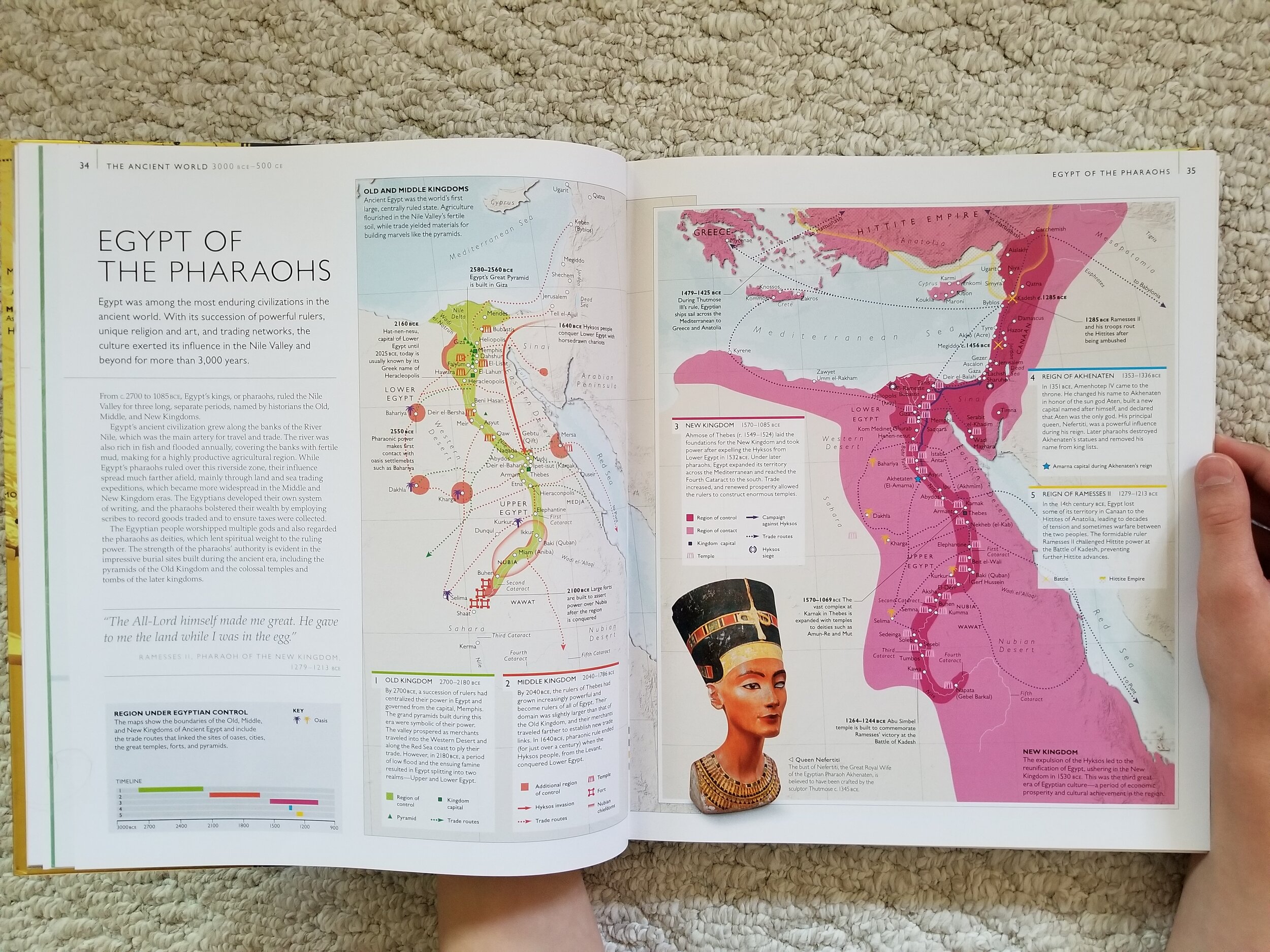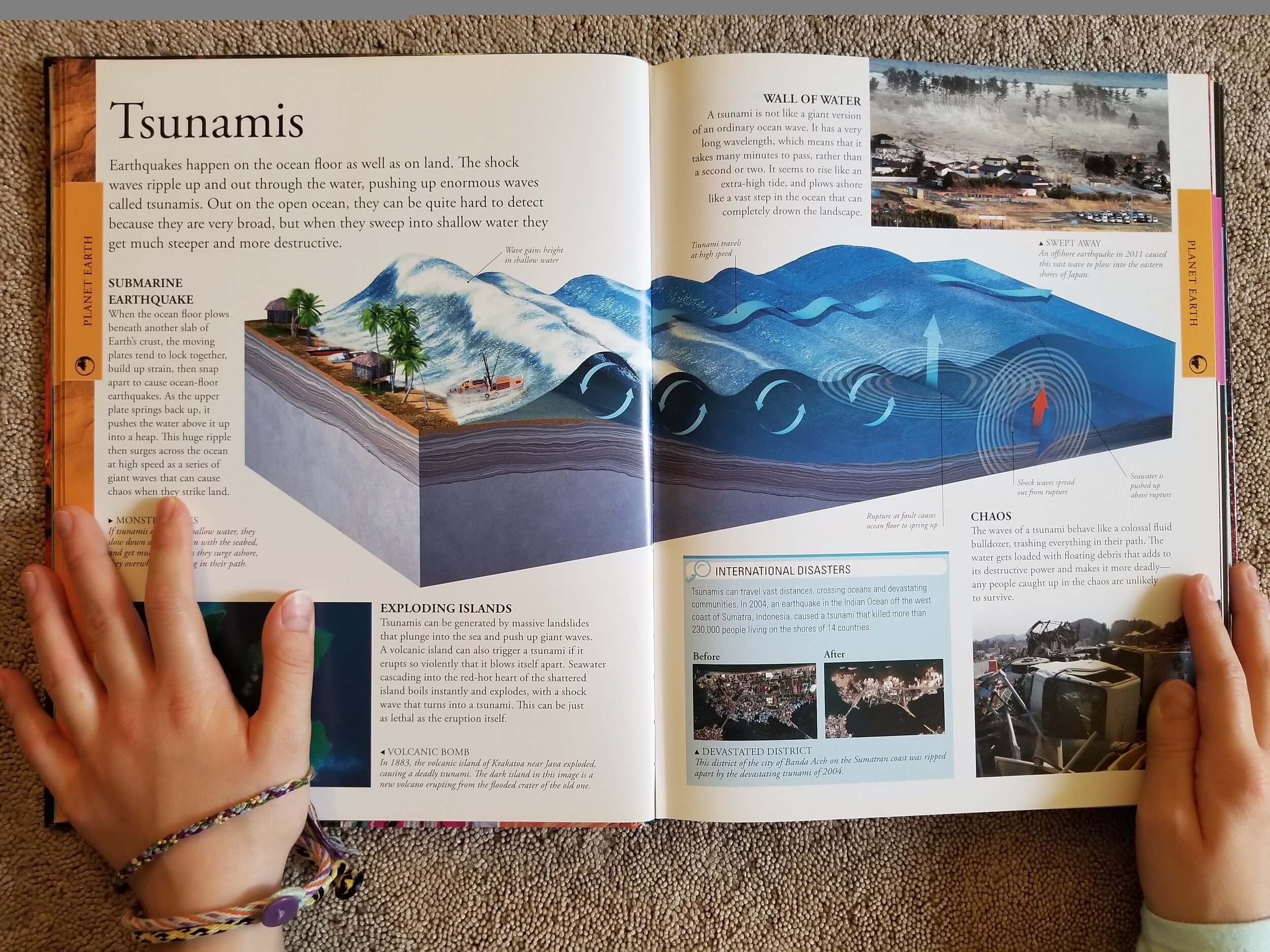Interdisciplinary Homeschool Geography: Geography Is Everywhere!
In my preceding blog post, I discussed the approach we have taken to studying geography in our homeschool. In this final post of my series on homeschool geography, I’m going to talk about how we incorporate geography into other subjects we study.
Geography is an integral component of history studies, as many historical events are intertwined with geography. Civilizations rose up in particular areas because of their proximity to water, geographical features have acted as physical boundaries between different groups of people and then as political boundaries, and some groups of people were able to temporarily evade colonization or invasion because they were geographically isolated. Some of our favorite history books have earned that position because of the plethora of historical maps they include. For the first round of history studies, I recommend The Kingfisher Atlas of World History. This book has really fun and colorful historical maps that are very engaging for children. For later rounds of history study, we just started using History of the World Map by Map (DK). This visually stunning book raises my excitement whenever I see it in my lesson plan.
As I mentioned in my previous post, it is also incredibly helpful to have kids drawing or labeling historical maps to accompany history lessons, as this helps them encode the information better than simply viewing a map (even if the maps are really captivating). To this end, I recommend the MapTrek program that I shared in my previous post. This program has many historical maps that can be integrated into your history studies - ancient civilizations, growth of empires, wars, and even some maps that will cross over into studies of religion. Two copies of each map are provided: one that is colored and labeled (basically an answer key), and one that is blank and ready for kids to label. They also include instructions for completing each map for children of different ages.
Geography has also played a role in the development and spread of religions, and maps are a useful tool for studying the expansion of different religions over time. There are fascinating books discussing the interplay between geography, culture, and religion that can be explored with older children, such as Geography of Religion (Esposito et al.). My children have conscientiously followed the religion we practice, and we’ve covered other religions as they fit into a larger historical context, so they’ve had snippets of the interplay between different religions and how they fit into a larger global picture. To introduce younger children to world religions, I recommend beginning with picture books that have stories about children from different faiths. If you feel like your child is ready to have an overview of different religions, a good book to start with is the Usborne Encyclopedia of World Religions. In my current lesson plan for geography, we are planning to do a complete survey of world religions after we complete our cycle through African geography. Religion is an integral component of cultures around the world and is foundational to understanding different geographical regions and the people who live there.
How does geography play a role in other subjects? Music, art, and literature are all heavily intertwined with geography, as I alluded to in my previous post. Historically, people from different geographical regions had unique musical and artistic styles. The literature produced by writers in different civilizations has also been heavily influenced by their culture. One of the best ways for children to engage with other cultures is to surround them with music, art, and literature that come from different places in the world. My kids are very enthusiastic about listening to new musical styles, and most children are very eager to try a new art style and enjoy trying to replicate the works of other artists. For literature, you can find collections of folktales that come from different places around the world, and your local library likely has many folktales for children that you can link to your geography studies. Even older children often enjoy folktales, and with older children you can discuss the themes and morals presented in the stories. You can also compare and contrast folktales from different places and talk about what values are shared by different cultures and what values are unique. You will often find similar folktale themes from places that are geographically distant, and it can lead to some fascinating discussions. For example, do a search for “Cinderella” folktales from different cultures. You might be surprised at how often the theme of “orphaned girl with mean stepmother and stepsisters overcomes adversity and marries a handsome, wealthy man” shows up in tales from different places.
Geography is highly intertwined with the study of the sciences. Physical geography greatly overlaps with earth science, and the nuances of what makes them different are probably only a concern to earth scientists and geographers. In our homeschool, we study earth science as a separate division in our science studies, focusing greatly on how geographical features are formed, plate tectonics, geology, atmosphere and climate, and the composition of the earth. Our geography studies tend to focus more on political geography, cultural geography, and cartography, because I know we will be studying physical geography when we cycle through earth science. If you’re looking for a really nice book for earth science (or physical geography), we have loved Geography: A Visual Encyclopedia (DK). For very young geographers, we have also used First Earth Encyclopedia (DK). Geography is also very important when studying plants and animals, as different places in the world can have widely different climates which generate different vegetation and animal life. Climate has also driven evolutionary change and migrations of different species. Historically, scientific advancement tends to happen in specific geographical regions during specific periods of time, as scientists influenced others in their general vicinity before the world was so interconnected that scientific achievements were easily shared between different groups of people. Cultural beliefs have greatly influenced scientific thought, and sometimes stifled scientific advancements when findings challenged prevailing religious beliefs or cultural ideologies.
I think the connections between geography and language are quite obvious. Many language programs include a cultural component and talk about the people who speak the language. It’s very interesting to study how different languages are related and it suggests the cultural overlap that happened historically between different groups. A fun project that we are using to link language to geography is a Latin passport for geography studies. My older kids are both learning Latin and enjoying it. While Latin is no longer spoken, much of English is derived from Latin and knowing Latin roots can greatly help with word decoding in English. To use the passport, the kids use rubber stamps to stamp in the name of each country they “visit” through books, literature, and projects. They also have fun flag stickers they can attach next to the name of each country. In our first round through geography, we made passports that were in English, but I thought it would be fun to use Latin for round two. My kids are huge fans of Harry Potter’s magical world, so the passport I designed in Latin can also be used to log magical travel between different places. I have made our Latin passport, as well as a passport in English, available in my online store. To take a look, click here or on the images.
I hope that my musings about geography encourage you to include geography as a subject worthy of exploring with your children. It is one of our favorite subjects to study, and I hope you will find that your children’s enthusiasm for learning about different places and cultures matches the excitement of my children!








